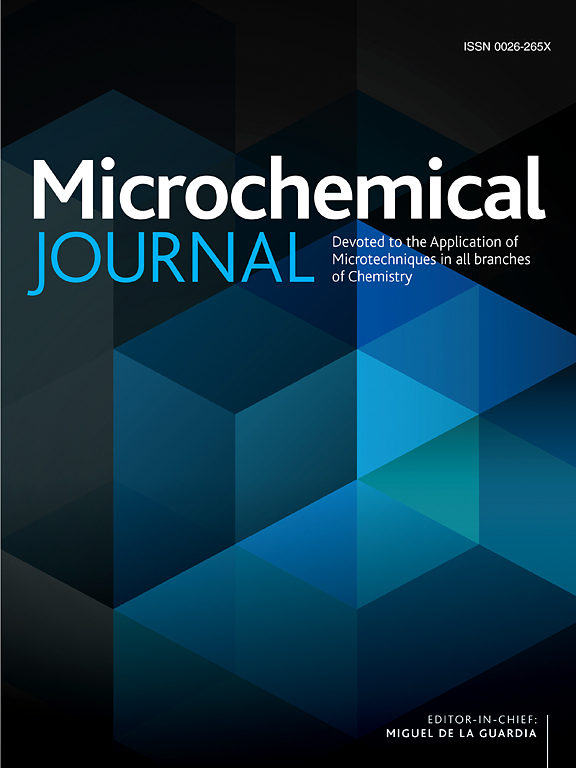基于电纺碳纳米纤维的硼酸盐亲和性分子印迹电化学传感器用于选择性检测卡那霉素
IF 4.9
2区 化学
Q1 CHEMISTRY, ANALYTICAL
引用次数: 0
摘要
由于使用不当,动物源食品中存在痕量卡那霉素(KANA)残留,这是一个严重的公共卫生问题,因此迫切需要开发灵敏且具有选择性的卡那霉素检测方法。在这项研究中,我们开发了基于分子印迹聚合物(MIPs)的电化学传感器来检测 KANA,将 Co、Mo 掺杂的碳纳米纤维(Co、Mo@CNFs)用于修饰玻璃碳电极(GCE)。然后,以 KANA 为模板分子,3-氨基苯硼酸(3-APBA)为功能单体(如 MIPs/Co,Mo@CNFs/GCE),通过电聚合反应合成 MIPs 层,通过硼酸亲和力促进选择性识别。Co、Mo@CNFs 的存在增强了原本绝缘的 MIPs 层上的电子传输,从而提高了传感器的选择性识别能力。在最佳条件下,MIPs/Co, Mo@CNFs/GCE 传感器可在 1 × 10-2 至 1 × 105 nmol-L-1 的浓度范围内精确检测 KANA,检测限为 2.56 pmol-L-1。此外,该传感器在复杂基质中的适用性也得到了验证,成功检测了血清和牛奶样品中的 KANA,回收率在 95.05 % 到 116.43 % 之间。这些结果证实,所提出的传感器可高效检测生物和动物源食品样品中的 KANA。本文章由计算机程序翻译,如有差异,请以英文原文为准。

Boronate affinity molecularly imprinted electrochemical sensor based on electrospun carbon nanofibres for selective kanamycin detection
The presence of trace kanamycin (KANA) residues in animal-derived foods from its improper use present a critical public health issue, making the urgent need for the development of sensitive and selective KANA detection methods. In this study, we developed molecularly imprinted polymers (MIPs)-based electrochemical sensor for the detection of KANA, incorporating Co, Mo-doped carbon nanofibres (Co, Mo@CNFs) to modify a glassy carbon electrode (GCE). Then, the MIPs layer was synthesized via electropolymerization using KANA as a template molecule and 3-aminophenylboronic acid (3-APBA) as the functional monomer (as MIPs/Co, Mo@CNFs/GCE), facilitating selective recognition through boric acid affinity. The presence of Co, Mo@CNFs enhanced electron transport across the otherwise insulating MIPs layer, thereby improving the sensor’s selective recognition capabilities. Under optimal conditions, the MIPs/Co, Mo@CNFs/GCE sensor demonstrated precise KANA detection within a concentration range of 1 × 10−2 to 1 × 105 nmol·L−1, achieving a detection limit of 2.56 pmol·L−1. Furthermore, the sensor’s applicability was validated in complex matrices, successfully detecting KANA in serum and milk samples with recovery rates ranging from 95.05 % to 116.43 %. These results confirmed that the proposed sensor is highly effective for detecting KANA in both biological and animal-origin food samples.
求助全文
通过发布文献求助,成功后即可免费获取论文全文。
去求助
来源期刊

Microchemical Journal
化学-分析化学
CiteScore
8.70
自引率
8.30%
发文量
1131
审稿时长
1.9 months
期刊介绍:
The Microchemical Journal is a peer reviewed journal devoted to all aspects and phases of analytical chemistry and chemical analysis. The Microchemical Journal publishes articles which are at the forefront of modern analytical chemistry and cover innovations in the techniques to the finest possible limits. This includes fundamental aspects, instrumentation, new developments, innovative and novel methods and applications including environmental and clinical field.
Traditional classical analytical methods such as spectrophotometry and titrimetry as well as established instrumentation methods such as flame and graphite furnace atomic absorption spectrometry, gas chromatography, and modified glassy or carbon electrode electrochemical methods will be considered, provided they show significant improvements and novelty compared to the established methods.
 求助内容:
求助内容: 应助结果提醒方式:
应助结果提醒方式:


